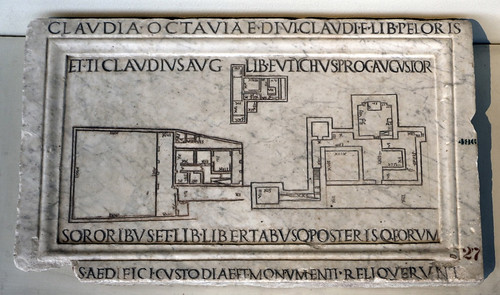
PREV ARTICLE
NEXT ARTICLE
FULL ISSUE
PREV FULL ISSUE
LOOSE CHANGE: OCTOBER 13, 2019This week we have non-numismatic articles that may appeal to various readers. -Editor Ancient Roman Visual Aids
Collectors of ancient coins may appreciate this one. -Editor 
The building plan for a mausoleum How did regular people within the ancient Mediterranean use visual aids such as lists, calendars, maps, tables, weights and measures, textual illustrations, and even building plans in to organize, access, and then understand the world around them? A new book by classicist and historian Andrew M. Riggsby investigates the types of information technologies (IT) drawn, painted, and inscribed on the surfaces of the ancient Roman world and explores how they shaped the daily life of Romans. As Riggsby demonstrates, effective graphic design has been a tricky but important ability for thousands of years. To read the complete article, see:
Bronze Age Gold Jewlery Find
Alan Luedeking forwarded this one about a cool treasure find - a 22-carat gold piece of jewelry dating back to the Bronze Age. Thanks. -Editor
A care worker by day, Vaughan had taken to strolling around the town in Cumbria, a remote port on England's western coast, with a metal detector. It was a few hours into one recent walk that he got a "strong signal" coming from the earth below, he told the Daily Mail. When he uncovered the metal about five inches below the ground, it turned out to be a circular piece of jewelry known as a torc. Initially Vaughan thought it was "a piece of climbing equipment, or perhaps coupling from a tractor." In fact, the thick, rod-like object was 11 ounces of solid gold, dappled with small indentations and slightly folding over itself, with one terminal overlapping the other to allow for an opening. Torcs have historically been worn as an indicator of great wealth and social status. To read the complete article, see:
Everything You Know About the Civil War is Wrong
This one was published in 2017, but I stumbled on it this week. Very interesting look at less obvious but very important economic causes of the U.S. Civil War. Well worth reading. -Editor  For most of us (including me), we attended public schools where we were provided roughly the same instruction regarding the Civil War: Our country was composed of the North, where people opposed slavery, and the South where slavery was embraced. Abraham Lincoln rose to the presidency and fought against the South to end slavery and saved the Union. Like most of my high school peers, this story seemed plausible enough to me and after all, it ended happily: Slaves were freed and the Union remained intact. Plausible enough until I read a couple of books by Charles Adams, a tax historian and author from New England — hardly a Southern extremist with an ax to grind. In these fascinating books, Adams explores how taxation affected historical events and how the popular interpretation of the Civil War survives in the face of some obvious facts. I had to revise my thinking. To read the complete article, see:
History of Desktop Publishing
Numismatic authors might appreciate this new history of desktop publishing. -Editor
To read the complete article, see:
Secret Formula for Eternal Youth
From the Good Clean Funnies list. -Editor The police recently arrested a man selling "secret formula" tablets he claimed gave eternal youth. When going through their files they noticed it was the fifth time he was caught for committing this same criminal medical fraud. He had earlier been arrested in 1794, 1856, 1928 and 1983.... To read the complete article, see:
 Wayne Homren, Editor The Numismatic Bibliomania Society is a non-profit organization promoting numismatic literature. See our web site at coinbooks.org. To submit items for publication in The E-Sylum, write to the Editor at this address: whomren@gmail.com To subscribe go to: https://my.binhost.com/lists/listinfo/esylum All Rights Reserved. NBS Home Page Contact the NBS webmaster 
|

